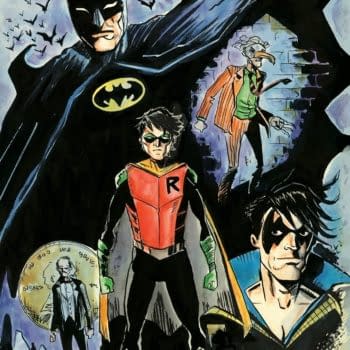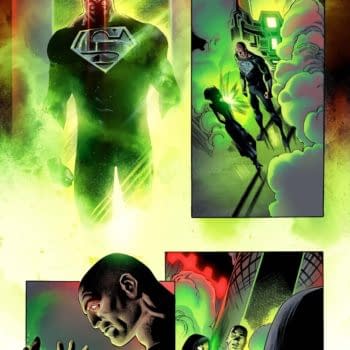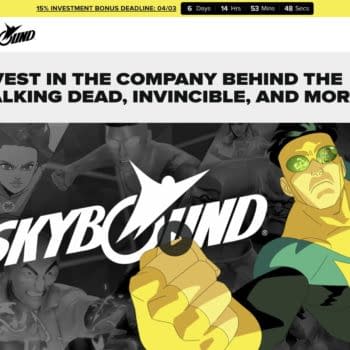Posted in: Do Anything. Thoughts on Comics and Things by Warren Ellis | Tagged:
Do Anything 008 by Warren Ellis
008
A section from a list of things that happened to comics on a Phildickian alternate world in 2009:
• David Gibbons knighted for services to architecture. "I was fucking robbed," says Peter Cook, architect and co-founder of Archigram, who realises that without the knighthood he is no longer a loveable eccentric but now simply a crazy man who mutters about strange buildings.
• Reissue of Alan Moore's "Voice Of The Fire" ambient/spoken-word trilogy of albums from 1982-5. Moore continues to refuse all royalties from his production work on U2's "The Joshua Tree," citing intellectual property theft and contractual irregularities. The launch party is held in a David Gibbons building, the controversial Millennium Space Fort in London.
• Bryan Hitch directs the remake of "Star Trek." Much is made of the unusual cinematography, combining the deep focal length of classical American filming with radical use of lens flare. Mixed reviews centre around the scene where Captain Kirk (Samuel L Jackson) plays classical music on a baby grand piano in his quarters while the Enterprise phaser-strafes the Klingon homeworld from space.
Atom Style is a good name: exuberant, American cosmic, and yet scented with the radioactive smoke of mass destruction, giant things stalking deserts and cities, the sense of being in thrall to things beyond our sight and knowledge. In fact, almost all of Fifties and Sixties superhero comic books could have been seen as Atom Style — radioactive chic complete with its own fashion concept. (Yes, fashion. Somewhere off in the distance, Jim Steranko's getting into his car. He'll be here soon. It flies.) Once you're doing Kirby Style, you're always going to be doing Kirby Style, if you're Jack Kirby.
The problem with Atom Style as a name is that in 1977, the year George Lucas made Druilletisms fly in STAR WARS, a Dutch cartoonist called Joost Swarte (whose work I first encountered in ESCAPE, a comics anthology magazine co-edited by Paul Gravett) coined the term to describe a European comics style emanating from the 1950s.
Obviously we're going to have to go and deal with him now.
A student of industrial design, Joost Swarte is still doing strafing runs on my house, riding shotgun in a Fifties-style Space Shuttle being piloted by industrial designer Raymond Loewy. He's also worked in architecture, designed in stained glass, and has been knighted by the Dutch Queen — which, as in the case of fellow architect Sir Peter Cook (whose ARCHIGRAM magazine featured comics art on its covers), probably serves to make him appear less mental. He is, if you like, fully accepted into the cultural conversation, this cartoonist who illustrated his own id as a moody, alienated, paranoid clown, Jope de Pojo. In conversation with Kim Thompson, Swarte said: "Jopo de Pojo inherited my love and ambition to be a rhythm-and-blues musician — all my doubts and my feelings of not being connected."
Two images from Swarte have remained with me since I first discovered his work in ESCAPE. One is of Jopo sadly plucking at a guitar, not really getting anywhere with it, the guitar going PLANK PLONK. (Which, in my head, suddenly connects with the end of anime FLCL, with the abandoned guitar that the protagonist can't really play yet, and the voiceover is talking of how nothing extraordinary ever really happens — and right at the end, the guitar seems to play itself. Two notes. PLANK PLONK.) The other is a self-portrait of Swarte drawing at a table: dipping his brush in a glass of beer and drinking the ink from its bottle. Which is as fine and perfect an illustration of the comics creator's life as any I've seen.
Swarte is very connected.
(In 1974, the Real Free Press of Amsterdam reprints a bunch of Will Eisner's SPIRIT comics. To make the page design work, they have to strip a SPIRIT logo down the left hand side. To fill it out, they add a little drawing of The Spirit at the bottom of the logo. Which was done by Joost Swarte. In 1996 Swarte designs a theatre for Haarlem. Eisner's father is a theatrical backdrop painter, and all of his analogies about comics are theatrical.)
In early 1977, Joost Swarte defines what is probably the most important comics art style to have come out of Europe. No-one had a name for it before: the ligne claire. The Clear Line. The style of Herge, of Tintin. I'm sure you can picture it. The style where all extraneous lines are eliminated, and only the lines that do work remain. A single line of exquisite clarity and control, producing deceptively simple and open figures in a method that is in fact extremely hard to do. You can't hide anything, in the Clear Line. Every shape must be rendered in the minimal amount of ink, but not at the expense of detail. There's little or no weighting on the line — making the line thicker or thinner to create spatial bias in the panels — no crosshatch, no shading, and no skimping on the realism of backgrounds. The characters, especially in Herge, tend to be a little cartoony: in combination with the detailed background work, the effect defined by Scott McCloud as "masking" comes into play.
McCloud explains masking: "Every major Disney feature sported fairly realistic backgrounds, if you look at them, and fairly simple major characters. Because really they're two different sorts of reality. We're supposed to experience, in a sensory way, those environments. But we're supposed to identify with the characters."
McCloud, of course, laid all this out in his revelatory book UNDERSTANDING COMICS, a work about comics told in comics, with McCloud himself doing his rhetorical turn as a masking-enabled Clear Line figure.
It is the style that Swarte himself works in. And when, later in 1977, Swarte wrote about the Atom Style, he did it as a Clear Line comic.
ANYTHING
I got to flip through a copy of Geoff Manaugh's THE BLDGBLOG BOOK, print annex to the fine BLDGBLOG blog at bldgblog.blogspot.com, the other month. You need this book. I mean, you need to be reading the blog, too, but you need to look for this book. It is a book about architecture. Which means it's a book about everything, including but not limited to all of history, all of the future, being completely mad, living in all things at all times and the death and also the saving of science fiction. Geoff Manaugh writes and thinks like some unholy hybrid of Umberto Eco, Paul Morley, William Gibson and an unhinged ayahuascero dressed only in pages from a furniture catalogue dated 10 December 2012. The book is a mad wunderkammer of mad and lovely things, making the real world into science fiction and making science fiction into the real world. The great joy of BLDGBLOG is when a discovered thing sends Geoff's brain into some lunatic alternate world of possibility, and then folds the whole the back on to the present day.
I worked out on a calculator that Geoff is approximately eighty times smarter than I am. But I don't know how to use the more complicated-looking buttons, so it could turn out to be more. Buy the fucking book.
COLOPHON
I can be sent things via Avatar Press at Avatar Press, 515 N. Century Blvd., Rantoul, IL 61866, USA, but I cannot promise a response or a review. Although, let's be honest, it's fairly likely, as eventually the ANYTHING section will need to be about comics. You can email me at warrenellis@gmail.com, but I warn you, it's a dump address, not my regular email address, so it can take me a few days to check it.
DO ANYTHING is © Warren Ellis 2009, all rights reserved.












